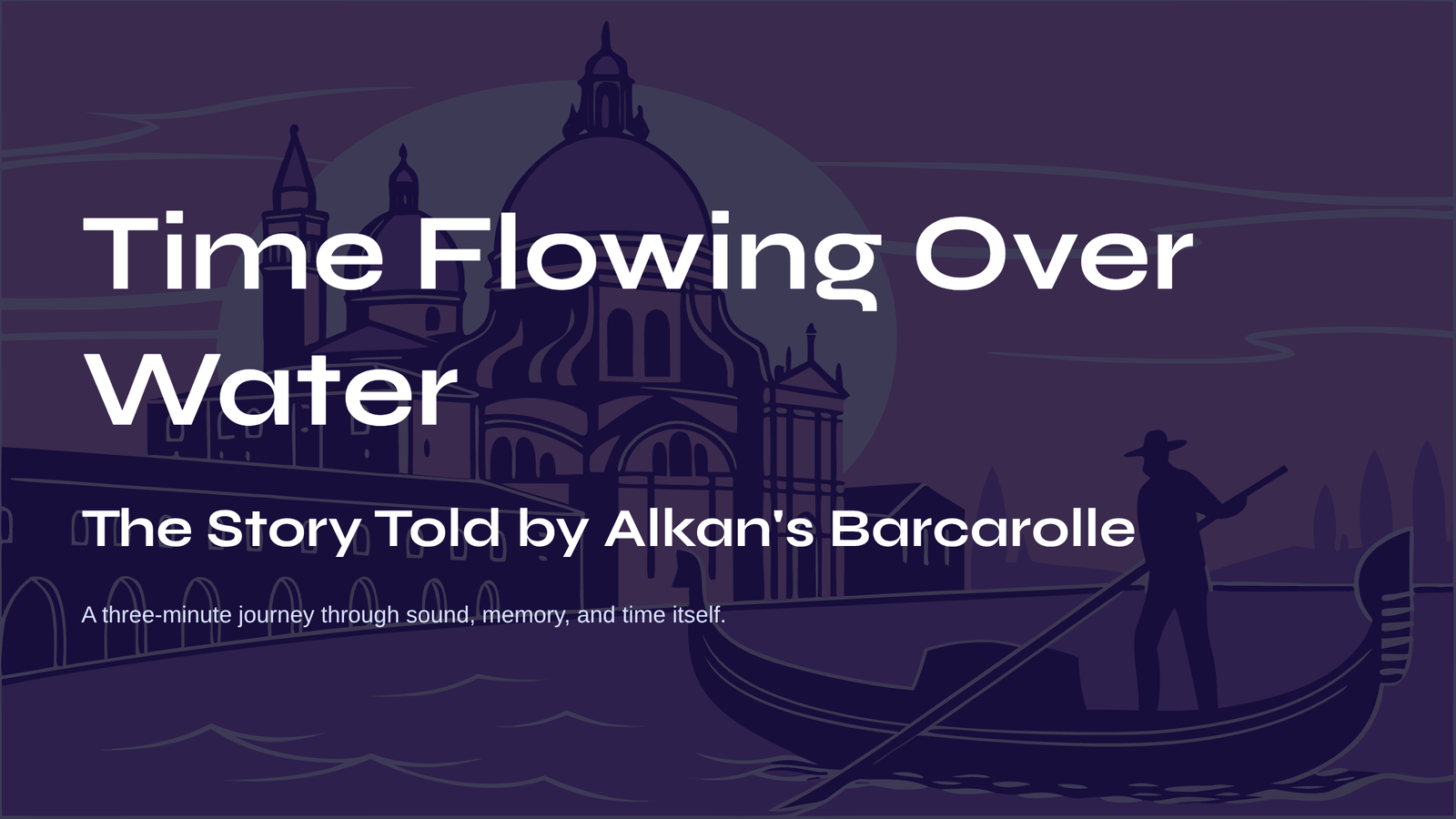Table of Contents
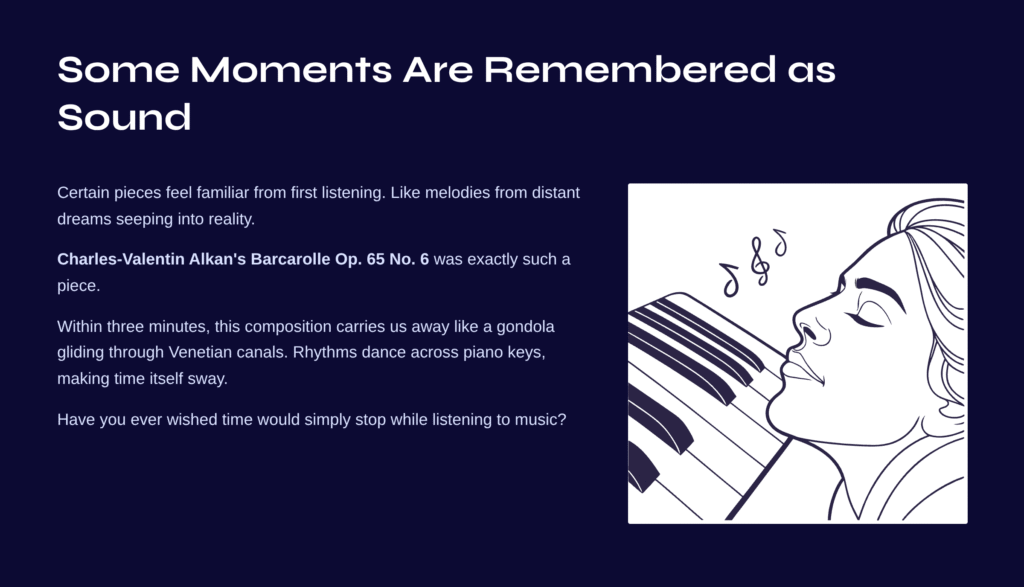
Some Moments Are Remembered as Sound
Certain pieces of music feel familiar from the very first listening, as if we’ve always known them. Like melodies from distant dreams seeping into reality. Charles-Valentin Alkan’s Barcarolle Op. 65 No. 6 was exactly such a piece for me.
Within its brief three-minute span, this composition carries us away like a gondola gliding through Venetian canals. Like waves lapping against the hull of a boat, the rhythms created by fingers dancing across piano keys seem to make time itself sway. Have you ever found yourself wishing, while listening to music, that time would simply stop?
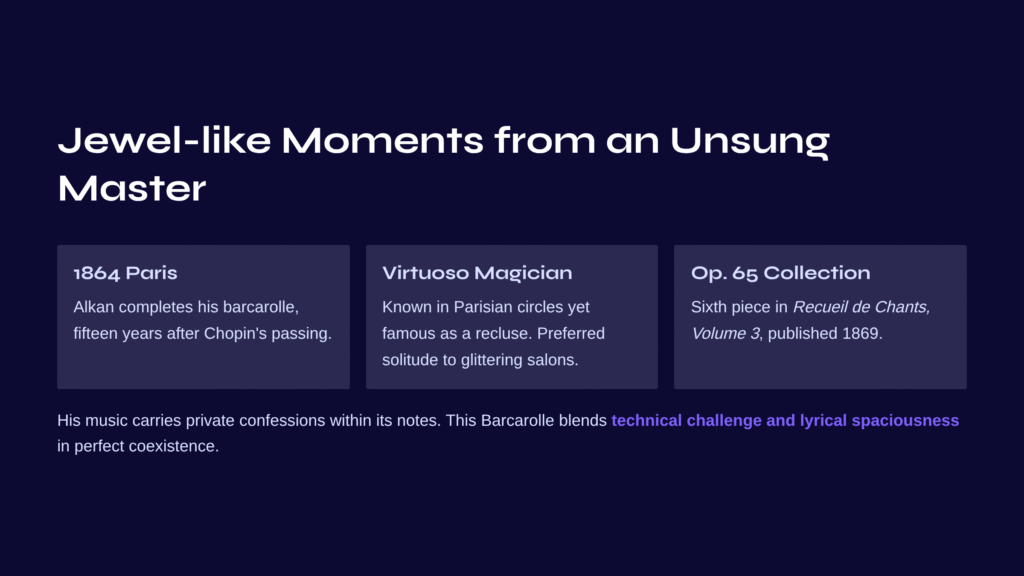
Jewel-like Moments from an Unsung Master
In 1864, within a Parisian composition room, Charles-Valentin Alkan was completing his own barcarolle. This was already fifteen years after Chopin’s passing, while Liszt continued his dazzling concert tours across Europe.
Alkan was known in Parisian musical circles as a virtuoso magician, yet he was equally famous as a recluse. He preferred the solitude of his private studio to the glittering salons, engaging with music in intimate communion. Perhaps this is why his music carries something like private confessions within its notes.
This Barcarolle forms the sixth piece in his Op. 65: Recueil de Chants, Volume 3, first published in 1869. True to its collection’s title suggesting “songs,” this piece flows with vocal-like qualities. Yet within this lies Alkan’s characteristic blend of technical challenge and lyrical spaciousness in perfect coexistence.
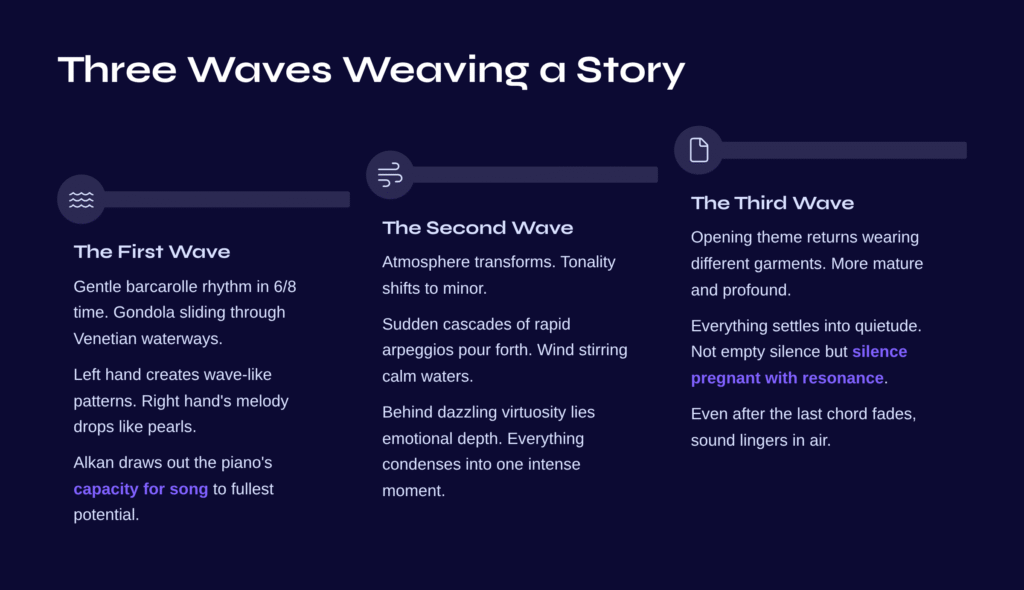
Three Waves Weaving a Story
The First Wave: The Magic of Tranquil Beginnings
The piece opens with the gentle barcarolle rhythm in 6/8 time. This rhythm evokes the motion of a gondola sliding through Venetian waterways. Above the left hand’s regular wave-like patterns, the right hand’s melody drops like pearls, one note at a time.
This melody resembles someone singing from afar—not quite clear yet deeply moving, not specific yet achingly nostalgic. Here, Alkan draws out the piano’s capacity for song to its fullest potential.
The Second Wave: Where Technique Meets Emotion
The middle section transforms the piece’s entire atmosphere. As the tonality shifts to minor, sudden cascades of rapid arpeggios and ornamental passages pour forth. This feels like a sudden wind stirring previously calm waters.
Here we encounter Alkan’s true nature. He was not merely a composer of beautiful melodies but an architect of sound. Behind the dazzling virtuosity lies emotional depth, controlled by the most delicate pedaling techniques. Everything condenses into this brief, intense moment.
The Third Wave: Returning Calm and Lingering Echoes
In the recapitulation, the opening theme returns, but now wearing entirely different garments. Having journeyed through the middle section’s experiences, the melody emerges more mature and profound. Crescendos and decrescendos breathe dramatic vitality into the composition.
The piece’s final section sees everything settle into quietude. Yet this is not empty silence but silence pregnant with resonance. Even after the last chord fades, its sound seems to linger in the air.
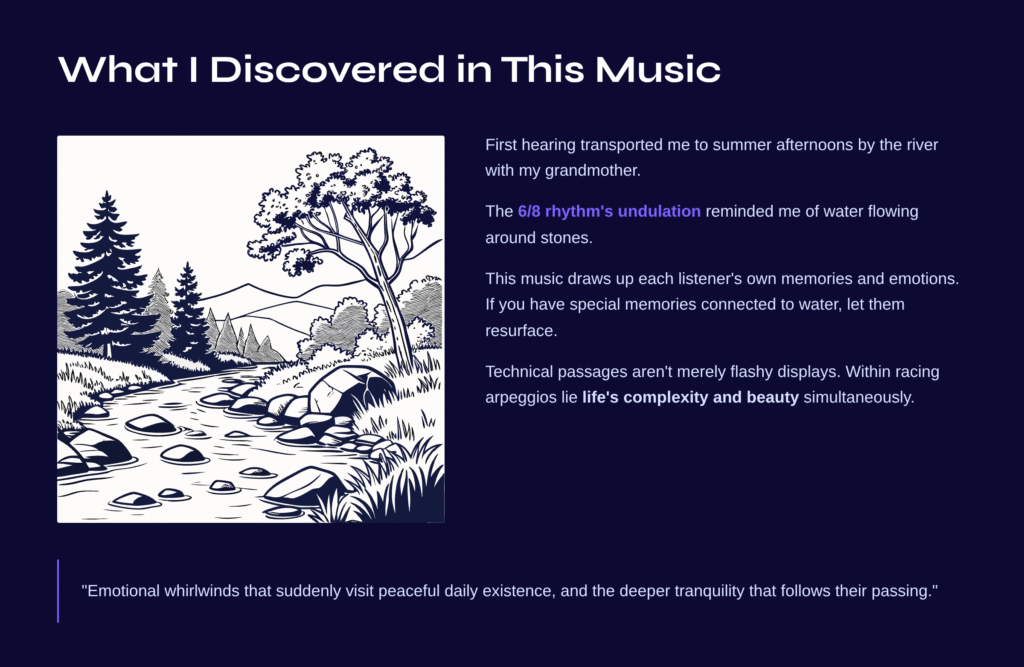
What I Discovered in This Music
When I first heard this piece, I was transported to summer afternoons spent by the river with my grandmother in childhood. There was no particular reason—just that the 6/8 rhythm’s undulation reminded me of water flowing around stones, embracing them as it passed.
Alkan’s Barcarolle is precisely this kind of music. Rather than telling specific stories, it draws up each listener’s own memories and emotions. If you too have special memories connected to water, try listening to this piece while letting those moments resurface.
Even the technical passages aren’t merely flashy displays. Within those racing arpeggios lie life’s complexity and beauty simultaneously. The emotional whirlwinds that suddenly visit peaceful daily existence, and the deeper tranquility that follows their passing.
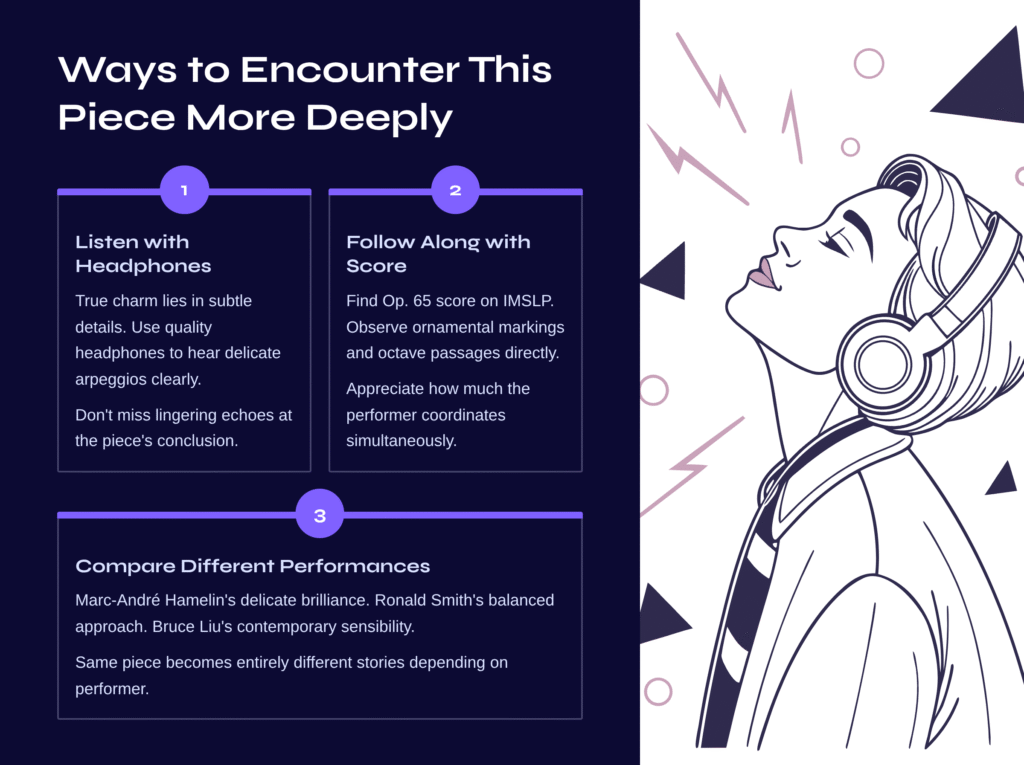
Ways to Encounter This Piece More Deeply
First Tip: Listen with Headphones
This piece’s true charm lies in its subtle details. Use quality headphones to clearly hear the delicate arpeggios and pedaling resonances. Don’t miss the lingering echoes at the piece’s conclusion.
Second Tip: Follow Along with the Score
Find the Op. 65 score on IMSLP and listen while following along. Observing the ornamental markings and octave passages directly will help you appreciate how much the performer must coordinate simultaneously, making the music feel more three-dimensional.
Third Tip: Compare Different Performances
From Marc-André Hamelin’s delicate yet brilliant interpretation to Ronald Smith’s balanced approach and Bruce Liu’s contemporary sensibility—the same piece becomes entirely different stories depending on the performer.
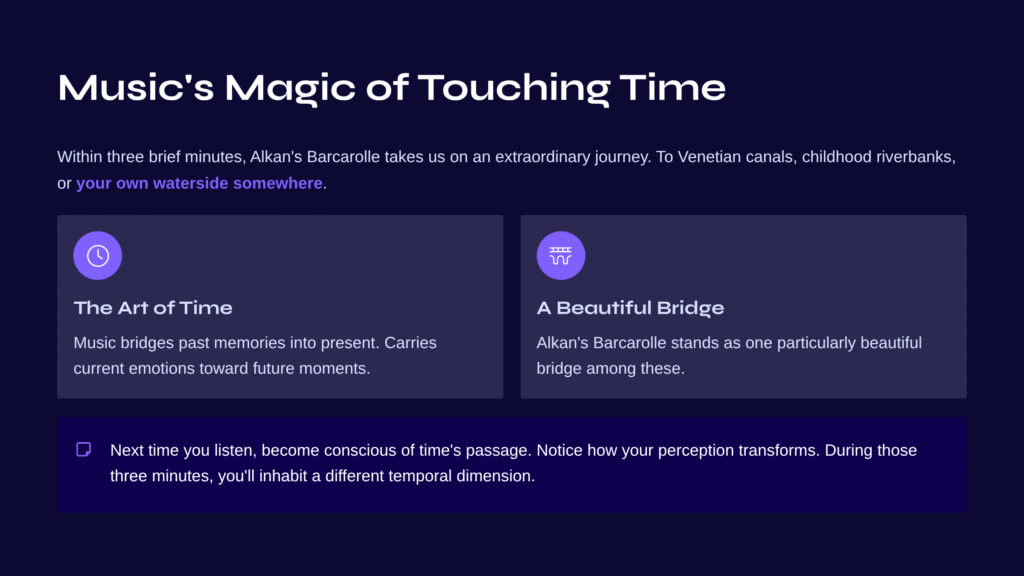
Music’s Magic of Touching Time
Within three brief minutes, Alkan’s Barcarolle takes us on an extraordinary journey. Whether to Venetian canals, childhood riverbanks, or your own waterside somewhere.
Music is ultimately the art of manipulating time. It bridges past memories into the present and carries current emotions toward future moments. Alkan’s Barcarolle stands as one particularly beautiful bridge among these.
Next time you listen to this piece, become conscious of time’s passage. From the moment the music begins until the final echo fades, notice how your perception of time transforms. During those three minutes, you’ll certainly inhabit a different temporal dimension than usual.
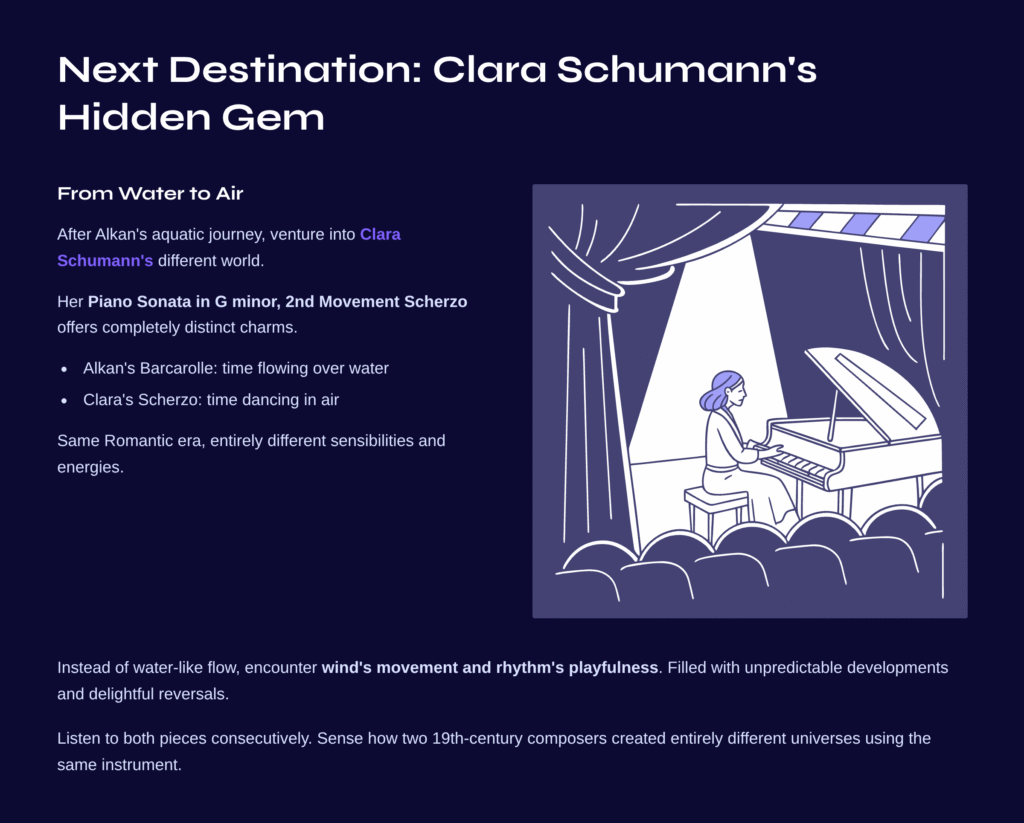
Next Destination: Clara Schumann’s Hidden Gem
After Alkan’s aquatic journey concludes, why not venture into the different world guided by Clara Schumann? Her Piano Sonata in G minor, 2nd Movement Scherzo offers charms completely distinct from Alkan’s lyrical flow.
If Alkan’s Barcarolle represents time flowing over water, Clara’s Scherzo embodies time dancing in air. Same Romantic era, yet entirely different sensibilities and energies. The musical personality and creativity that Clara displays as a female composer will lead you toward fresh surprises.
In Clara’s Scherzo, instead of Alkan’s water-like flow, you’ll encounter wind’s movement and rhythm’s playfulness. Filled with unpredictable developments and delightful reversals, this piece creates perfect contrast when heard after the Barcarolle’s meditative afterglow.
Listen to both pieces consecutively. You’ll sense how these two 19th-century composers created entirely different universes using the same instrument—the piano.
